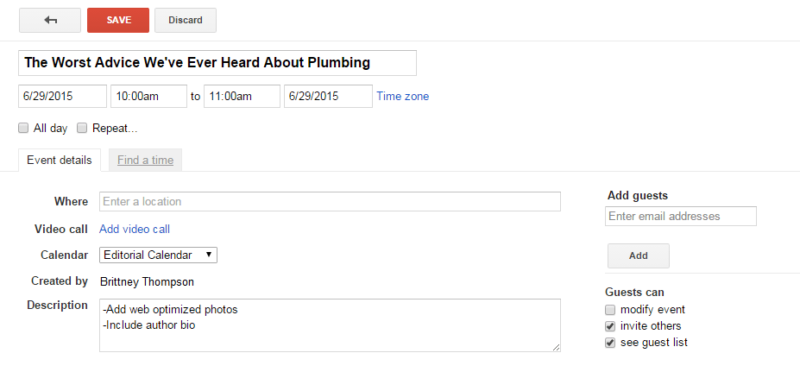How To Budget Quality Content As A Small Business Part 2

The average cost to generate a lead through inbound marketing ($143) is about half the average for outbound marketing ($373). Yet many small businesses today continue to neglect their inbound channels for more traditional outbound marketing strategies. This is often because building a successful content campaign requires some hefty upfront costs and time to see real ROI.
However, you don’t have to be a large corporation to reap the benefits of a well-laid content plan. Good content simply means providing value to consumers through information that answers questions and solves relevant problems. And luckily, you can provide that kind of content without a large budget. You just have to get creative and get smart about your content production tactics.
In Part 1 of this series, we talked about how to set a budget and a general content strategy for your small business. Now learn how you can get more out of your content, no matter how conservative your budget and resources.
Curate Content
According to Content Marketing Institute, the number one challenge facing business marketers is creating engaging content (followed closely behind by creating content consistently). One tactic that can help you do both is adding content curation to your strategy. 
Content curation is collected content from third-party sources with added commentary or review by the curator. Curation is a great way to establish yourself (and your business) as an authority in a chosen topic or industry and save time on production. Instead of having to come up with new post ideas every day or every week, you can devote part of your production purely to curation. When consumers see relevant, useful, and engaging content gathered together from authoritative sources with added insights, you will become an increasingly trusted source of information.
The key to successful curation is added value. With millions of pieces of content being published every day, you don’t want to merely add to the noise. Based on your business’ target audiences, hone in on a particular topic that those customers will find interesting and useful. Then work to find quality content that matches. Curated content should suit the following criteria:
- Relevant
- Credible
- Diverse
- Fresh
The great thing about curation is that it can be applied through various channels, depending on your overall marketing strategy. If your consumers respond best to emails, include curated content in a weekly newsletter. If you’re scrambling to find things to post on social media, share curated links and an illustrative comment on Facebook, Twitter, or LinkedIn. Curated content is also a great addition to a designated blog. Not only does it keep your publishing frequency high, but it also adds content-rich pages for search engines to index, improving your ranking factors and SEO.
Repurpose Old Content
Working off a shoestring budget means having to get creative. Instead of using valuable time and resources to brainstorm and produce brand new content repeatedly, look for ways you can repurpose old ideas. The more you recycle your best content, the more mileage you’ll get out of each piece (and the more time and money you’ll save). 
For example, let’s say you spent a couple hours piecing together a solid blog post. It is helpful, relevant, and engaging. Instead of letting that great information stagnate and get lost in your blog archives, use it as a jumping off point for other forms of content. For instance, use the content from the blog to create a white paper. Simply convert the content into a pdf file and polish the copy into a professional format. Here are a few other forms you can recycle your post into:
- Slide Deck
- Infographic
- Video
- Podcast
Depending on the interests and locations of your target audiences, you can tailor not only the information you produce, but the format it is published in for maximum staying power. Plus, the more content you can produce in different formats and channels, the better your SEO will be and the more robust your website will look.
Appoint One Person or Team to Manage Content
When you’re working on a tight budget, maximizing your efficiency is key. To ensure your content campaign is cohesive and organized, designate one person or a small team (if you have the resources) to manage the content. Assigning a point man to the project will save you valuable time and increase the efficiency and effectiveness of your campaign.
However, this isn’t to say that only one person should bear the brunt of the work. Rather, appointing one person or team to oversee the campaign keeps your strategy and its implementation tight. Once you have a project manager in place, by all means delegate the actual content production across your teams. Which leads us to the next tip….
Have Employees Contribute
If you’re running a small business, you don’t have time to brainstorm and produce all of the content necessary for a successful marketing campaign yourself. However, this doesn’t mean your campaign has to fall behind. Make full use of your in-house resources by encouraging your employees to contribute and delegating assignments across teams. 
The key to success here is editing. Not all of your employees are going to be writers, and that’s okay! That doesn’t mean they don’t have great ideas and insights to add; you’ll just want to make sure that you have clear standards in place and at least one solid writer/editor to vet each piece of content before it is published. With multiple people contributing from various departments, you’re sure to get some great content that boasts the authority of expert perspectives.
Encourage User-Generated Content
In a similar vein, don’t be afraid to look outward for content creation. Studies show that consumers find user-generated content 50 percent more trustworthy and 35 percent more memorable than other media.  In other words, consumers are more interested in what their peers have to say about you, than what you have to say about you. So take advantage of this! Go directly to your customers for content.
In other words, consumers are more interested in what their peers have to say about you, than what you have to say about you. So take advantage of this! Go directly to your customers for content.
For example, send out a poll or have a photo contest where customers can submit their own images on a topic related to your business or even a cause your business supports. Burberry did this successfully with their Art of the Trench site. In 2009, the company launched a campaign where customers could post pictures of themselves wearing Burberry’s most iconic product: the trench coat. The platform appealed to both existing and aspiring customers, allowing people to comment, share, and “Like” their favorite looks. As a result, Burberry’s Facebook following grew to over 1 million by 2010, and e-commerce sales grew 50% year-over-year.
Giving your audience a voice is a great way to get them invested in your brand. While you may not be a globally recognized brand like Burberry, you can still run successful user-generated campaigns. By shining the spotlight on your customers, you make it about them—and that’s a great way to win loyalty and a positive image.
Use a Publishing Calendar
With the pressures of running a small business, you don’t have time to waste on inefficient content production. Enter the editorial calendar. Mapping out your content plans on a publishing calendar will simplify your schedule and help you and your team stay on track with your campaign. 
There are plenty of editorial calendar options out there—some more sophisticated than others. However, you don’t have to spend a lot of money for great functionality. Google Calendars works just fine—and it’s free! Simply create a calendar specifically for Content Publishing, and fill in time slots for when you want to publish.
The nice thing is that you can share the calendar with your team, assign specific authors to individual posts and schedule out recurring events easily. Hubspot has a great tutorial on how to use Google Calendars for your editorial schedule. Whatever program or format you use, just be sure it simplifies your organization process, rather than complicates it.
Don’t Stretch Yourself Too Thin
One of the easiest mistakes you can make when starting a content campaign is to spread yourself too thin. A well-polished campaign takes time to develop. Though some businesses are pumping out multiple posts per day across multiple platforms, that doesn’t mean you need to be at that point right away.
Start small and focus on quality over quantity. Rely on your coworkers and employees to help bear the content production burden. Use your customers to fill in some of the gaps on your editorial calendar. If you find that the scope of your initial strategy is too broad, don’t be afraid to rein it in a bit. At the end of the day, quality and consistency are the most important factors in your content success. As you build on a foundation of quality, the frequency and quantity will also increase.
Content marketing can be a daunting prospect for small businesses. However, you don’t need the budget of a big brand to make a big impact. Be creative and use the resources available to you to stretch your content and your dollars. With the help of curation, repurposing, your employees and even your own customers, you can build a strong and successful campaign without breaking the bank.



test
Great article and tips on how to make a budget stretch and still create lots of good quality content and copy.
Good Article Brittney !, those are great tips on how to crate content marketing for a small business. I like the idea on not spreading to thin and to use the calendar to organize the content!
I love what you said about re-purposing old content, this is a great way to save on money and resources. Great Post!
I personally seem to find user generated content to be more memorable. I really like the part on that!